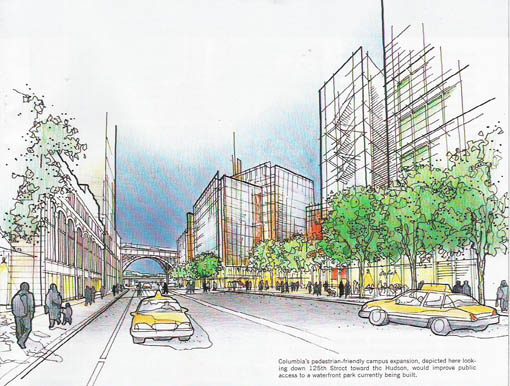A Traffic-Free Future for Harlem

This is an artist’s rendering of what West 125th Street would look like after Columbia University’s expansion is completed more than a decade from now. (It is included in an overview of the plans that appears in the print edition of Columbia magazine, which, um, hasn’t updated its web presence in a while.) Regardless of whether you’re in favor of or against the expansion, it is clear that Columbia is trying hard to persuade skeptics and opponents that the expansion will be a good thing for this part of Harlem.
Toward that end, the image grossly underestimates the amount of traffic on West 125th Street. You see two taxis in the foreground that seem to be barely moving, and the faint outlines of a car or maybe two in the distance. Then there’s 46 pedestrians and a dog on the sidewalk, another 10 to 12 people inside a cafe, a bunch of vivid trees and some buildings.
Three or four cars on 125th Street? 125th Street leads to the Henry Hudson Parkway, and is the major river-to-river crosstown link north of Central Park. There are never that few cars on it during daylight hours. The street is packed all day long, buses inching along amid the plodding, throbbing or stifling traffic.
I don’t mean to single out Columbia. It is common for architectural renderings to minimize the traffic. And why shouldn’t they? Everybody hates it, even the people who are sitting in it and helping to create it. In the idealized image of a city, there is a lot less traffic. That’s why community board meetings are dominated by complaints that this or that development will increase traffic. The perplexing thing is that community board meetings are also dominated by complaints that ample cheap parking, the greatest cause of heavy traffic, is somehow being threatened.